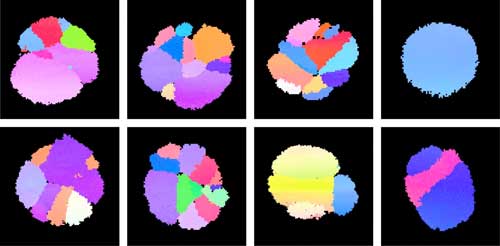| Posted: Oct 24, 2017 |
Single nanoparticle mapping paves the way for better nanotechnology
(Nanowerk News) Researchers at Chalmers University of Technology and the Technical University of Denmark have developed a method that makes it possible to map the individual responses of nanoparticles in different situations and contexts. The results pave the way for better nanomaterials and safer nanotechnology and were recently published in the journal Nature Communications ("Grain boundary mediated hydriding phase transformations in individual polycrystalline metal nanoparticles").
|
 |
| Svetlana Alekseeva and co-workers have produced maps of individual nanoparticles. The eight images show eight different nanoparticles of the same substance, palladium. Each nanoparticle consists of a number of grains, which are displayed as different coloured fields on the images. The properties and response patterns of the various grains differ, and these in turn determine the properties and responses of the nanoparticles when they come into contact with other substances. (Image: Svetlana Alekseeva) (click on image to enlarge)
|
|
In the future almost all new technology will be based on nanotechnology in some form. But nanoparticles are temperamental personalities. Even when they look the same from a distance, they are obstinately individual when you zoom in to each individual one.
|
|
Svetlana Alekseeva and Christoph Langhammer at Chalmers University of Technology in Sweden, together with researchers at the Technical University of Denmark, have discovered why different polycrystalline nanoparticles behave so distinctly when they come into contact with hydrogen. This knowledge is essential in order to develop better hydrogen detectors, which are expected to play an important role in the safety of hydrogen cars.
|
|
"Our experiments clearly showed how the reaction with hydrogen depends on the specifics of the way in which the nanoparticles are constructed. It was surprising to see how strong the correlation was between properties and response - and how well it could be predicted theoretically," says Svetlana Alekseeva, a Postdoc at the Department of Physics at Chalmers University of Technology.
|
|
A nanoparticle of a certain material is comprised of a number of smaller grains or crystals. The number of grains and how they are arranged is therefore crucial in determining how the particle reacts in a certain situation or with a certain substance.
|
|
Alekseeva and her collaborators have produced maps - effectively virtual portraits - of individual palladium nanoparticles. The images show the grains as a number of fields which are combined into a map. Some particles consist of a large number of grains, others have fewer grains, and the fields border on one another in different ways.
|
|
This new method of characterising nanoparticles is based on a combination of electron microscopy and optical microscopy. The same individuals are examined using both methods and it is possible to monitor their response when they encounter other substances. This therefore makes it possible to map the basic material properties of nanoparticles at an individual level, and see how these correlate with the response of the particles when they interact with their environment.
|
|
As a result an almost infinite range of possibilities are opened up for further research and for the development of products and nanomaterials which are both technically optimised and safer from an environmental and health perspective.
|
|
The nanoparticles that have been investigated also operate as sensors in themselves. When they are illuminated, they reveal how they react with other substances, such as various gases or fluids. Langhammer's research team is currently working on several projects in this area, including some relating to hydrogen detection.
|
|
But knowledge about nanoparticles is needed in a range of different fields in society. These include, for example, in new electronic devices, batteries, fuel cells, catalytic converters, textiles and in chemical engineering and biotechnology. There is still a lot we do not know about how these small particles operate or will come to affect us and the environment in the long term.
|
|
"Nanotechnology is developing fast in the world, but so far the research into nanosafety is not happening at the same pace. We therefore need to get a much better grasp of the risks and what distinguishes a hazardous nanoparticle from a non-hazardous one," says Christoph Langhammer, Associate Professor at the Department of Physics, at Chalmers.
|
|
"Our work indicates that not everything is what it seems - it's the details that are crucial. To understand if and why nanoparticles are hazardous to humans, animals or nature, we also need to look at them individually. Our new method now allows us to do this."
|

